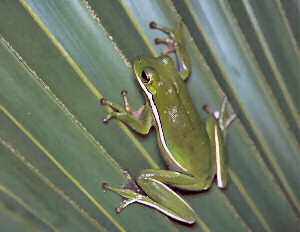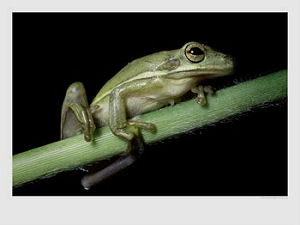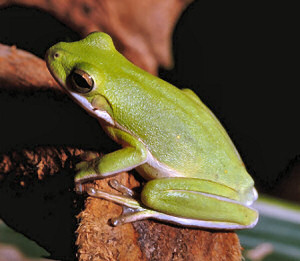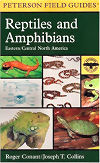
HOME
INTRO
SYMBOLS
ALMANAC
ECONOMY
GEOGRAPHY
STATE MAPS
PEOPLE
FORUM
NEWS
COOL SCHOOLS
STATE QUIZ
STATE LINKS
BOOK STORE
MARKETPLACE
GUESTBOOK
CONTACT US


Tweet
Double click on word for definition.
Georgia State Amphibian

Georgia State Amphibian: Green Treefrog
Photograph: Jane M. Rohling, U.S. Fish & Wildlife Service
An idea that originated in a 4th grade classroom at Armuchee Elementary School, in Rome, has finally been rewarded.
It was 2002 and the Armuchee School 4th graders, studying science and government with teachers Ruth Pinson and Marilyn McLean, discovered that the State of Georgia was not represented by an official amphibian.
In 2003, House Bill No. 256, designating an official state amphibian, was sponsored by Representative Barbara Reece, of Menlo. Rep. Reese, a retired schoolteacher, could not get the bill passed by the House of Representatives.
In 2004, House Bill No. 365, again sponsored by Rep. Reese, was introduced. This time, the legislation made in through the House of Representatives but failed in the Senate.
On January 24, 2005, Senate Bill No. 41 was introduced and read in the Georgia State Senate for the first time. In his bill, Senator Preston Smith of Rome proposed, for the third time in as many years, that the green treefrog be made the official amphibian of the State of Georgia.
The third time is the charm! This year, the tiny, 2" green treefrog was a shoe-in. In about two months the green treefrog garnered the approval of both houses of the Georgia General Assembly. It was forwarded to the governor on April 13.
It took the governor little bit of time to get around to signing Preston Smith's legislation into law. But sign it he did.
On May 9, 2005, Governor Sonny Purdue signed Senate Bill No. 41 into law making the green tree frog the "official Georgia state amphibian.
05 LC 28 1909
Senate Bill 41
By: Senator Smith of the 52nd
PASSED
A BILL TO BE ENTITLED
AN ACT
To amend Article 3 of Chapter 3 of Title 50 of the Official Code of Georgia Annotated, relating to state symbols, so as to designate the green tree frog as the official state amphibian; to provide for legislative findings; to provide for related matters; to repeal conflicting laws; and for other purposes.
BE IT ENACTED BY THE GENERAL ASSEMBLY OF GEORGIA:
SECTION 1.
The General Assembly finds and determines that:
(1) The green tree frog's (hyla cinerea) habitat includes nearly all of Georgia, so virtually all Georgians are familiar with it or have a great opportunity to see its conspicuous bright color and striped markings;
(2) Large aggregations of calling males create conspicuous and characteristic nighttime choruses during the warm months;
(3) All other major groups of wildlife, including mammals, birds, reptiles, fish, insects, trees, and wildflowers, are represented by state symbols, and amphibians are a crucial link in the state's ecosystem;
(4) Official recognition of a state amphibian could help correct the false impression that amphibians and reptiles are one and the same;
(5) The State of Georgia is home to 85 different species of amphibians, which gives it the distinction of having the second greatest amphibian diversity of any state in the United States behind North Carolina;
(6) Well-publicized world-wide decline of amphibians has become a major conservation concern and the exclusion of amphibians from our official state symbols list could possibly contribute to a sense of complacency towards this loss of biota;
(7) Amphibians are excellent indicators of water and air quality due to their porous skin and habit of moving between aquatic and terrestrial habitats, and declines in their numbers can serve as early warning signs that environmental conditions may be deteriorating in localized areas; and
(8) Establishing an official state amphibian is necessary to fully recognize our diverse wildlife and the green tree frog is deserving of the attention and appreciation of the citizens of this state by designation as the official state amphibian.
SECTION 2.
Article 3 of Chapter 3 of Title 50 of the Official Code of Georgia Annotated, relating to state symbols, is amended by adding a new Code Section 50-3-81 to read as follows:
"50-3-81.
The green tree frog is designated as the official Georgia state amphibian."
SECTION 3.
All laws and parts of laws in conflict with this Act are repealed.
There are two species of treefrog commonly found in Arizona. Senate Bill No. 41 referred to Hyla cinera in section 1. Unfortunately, no species was noted in section 2, amending Article 3 of Chapter 3 of Title 50 of the Official Code of Georgia Annotated. Though not specified by statute, we might assume that Hyla cinera was the intended species.
About the Green Treefrog

Georgia State Amphibian: Green Treefrog
[ Treefrog prints ]
The green treefrog is considered to be the one of the most beautiful tree frogs in North America. Its color ranges from bright, leaf green to olive green. A yellow to white stripe runs from its jaw along each side to its hip. Hyla cinerea grows to be about 1 3/4 to 2 1/2 inches long. Its legs are about 1 1/2 times as long as its body, which helps it to jump from 8 to 10 feet when desired. Its toes end in round pads that allow it to climb around in trees very comfortably.
Green treefrogs are found in swamps, borders of lakes and bayous, on floating vegetation, in trees and bushes near water, in Spanish moss or under bark on trees, and any place well supplied with water or dampness. At night they can be found clinging to house windows or windowsills preying on insects attracted by the artificial light.

Louisiana State Amphibian: Green Treefrog
In spring (by May) adult male treefrogs get out and about looking for mates. Their evening calls have been described as sounding like banging a cowbell with a stick. Some compare the sound to the words "Duck! Duck!" or "Quank! Quank!" The sounds they make give rise to some other names for the Green Treefrog; Cowbell Frog; Bell Frog; and Fried Bacon Frog among them. Where green treefrogs are plentiful, one can look forward to a grand chorus ever year from sometime in May through July.
The green treefrog is such an impressive specimen, that the incomparable Kermit the Frog was modeled after it. From the wilds of Louisiana to a TV Star on the Hollywood Walk of Fame is not a bad accomplishment for a little green treefrog.
Georgia Law
The following information was excerpted from the Georgia Code, Title 2, Chapter 10.
TITLE 50. STATE GOVERNMENT
CHAPTER 3. STATE FLAG, SEAL, AND OTHER SYMBOLS
ARTICLE 3. OTHER STATE SYMBOLS
O.C.G.A.§ 50-3-81 (2007)
§ 50-3-81. Official amphibian
The green tree frog is designated as the official Georgia state amphibian.
HISTORY: Code 1981, § 50-3-81, enacted by Ga. L. 2005, p. 316, § 2/SB 41.
Sources...
The Associated Press. "Green tree frog approved as officials state amphibian." AccessNorthGa.com. Jacobs Media Corporation, 25 Apr 2005. Web. 1 Jul 2005.
Baxter, Tom, and Jim Galloway. "Flag it: A green light for frog bill." The Atlanta Journal-Constitution. The Atlanta Journal-Constitution, 23 Feb 2005. Web. 1 Jul 2005.
Emerson, Bo. "Tree frog may leap into officialdom." The Atlanta Journal-Constitution. The Atlanta Journal-Constitution, 02 Mar 2003. Web. 9 Jul 2005.
"2005-2006 Regular Session - SB 41 State Amphibian, Official; designate the green tree frog." Georgia General Assembly. State of Georgia, 01 Jul 2005. Web. 9 Nov 2013.
"Georgia Code." Georgia General Assembly. 2008. 10 February 2009 .
Additional Information
The Green Tree Frog: How a Bill Becomes a Law: Short film created and produced by Georgia Public Broadcasting.
Green Treefrog Hyla cinerea: From GeorgiaInfo.
Green Treefrog (Hyla cinerea): The University of Georgia Savannah River Ecology Laboratory.
Green Treefrog: Tree frogs at the National Wildlife Federation.
Green Treefrog, Hyla cinerea: United State Geological Survey (USGS): Northern Prairie Wildlife Research Center.
Amphibian Research and Monitoring Initiative: Amphibian Species Descriptions from the Southeast Amphibian Research and Monitoring Initiative.
Hyla cinerea (green treefrog): University of Michigan Museum of Zoology: Animal Diversity Web.
Green Tree Frog (Hyla cinerea): Amphibiancare.com is a collection of articles, care sheets, photographs, and resources related to the captive care and understanding of amphibians and reptiles.
State amphibians: Complete list of official state amphibians from NETSTATE.COM.
More symbols & emblems: Complete list of official Georgia state symbols from NETSTATE.COM.
![]() Frog and Toad Posters and Prints: Frog and toad posters and prints from AllPosters.com.
Frog and Toad Posters and Prints: Frog and toad posters and prints from AllPosters.com.
What is an Amphibian? (The Science of Living Things) , by Bobbie Kalman and Jacqueline Langille, 32 pages, Crabtree Publishing Company (2000). Reading level: Ages 9-12. The large, full-color photographs and illustrations that pepper every page of these books will catch the eye of browsers but it is the informative, easy-to-read texts that will hold their interest.
Peterson First Guide to Reptiles and Amphibians , by Robert C. Stebbins, Joseph T. Collins and Roger Conant. Edited by Roger Tory Peterson. 128 pages, Houghton Mifflin Harcourt (April 15, 1999). From mudpuppies to rattlesnakes, this fascinating guide for young nature lovers describes the habits and habitats of these secretive and sometimes bizarre animals, and includes tips on how to catch and care for frogs, snakes, turtles, lizards, salamanders, and toads.

A Field Guide to Reptiles & Amphibians of Eastern & Central North America, by Roger Conant and Joseph T. Collins, 640 pages, Houghton Mifflin Harcourt; Fourth Edition edition (May 15, 1998). This newly designed field guides features detailed descriptions of 595 species and subspecies. The 656 full-color illustrations and 384 drawings show key details for accurate identification. More than 100 color photographs and 333 color photographs and 333 color distribution maps accompany the species descriptions.
Firefly Encyclopedia of Reptiles and Amphibians, edited by Tim Halliday and Kraig Adler, 240 pages, Firefly Books (September 7, 2002). With lush color photographs and lavishly detailed illustrations, this encyclopedia presents a striking abundance of information at a glance. Also noteworthy is the scholarly text, a comprehensive overview of these frequently studied phyla.
Care and Breeding of Popular Treefrogs: A Practical Manual for the Serious Hobbyist, by Philippe de Vosjoli, Robert Mailloux, Drew Ready. 205 pages, Advanced Vivarium Systems (January 1, 1997) This book is written by experienced and recognized frog herpetoculturists and focuses on the care of popular tree frogs now sold in significant numbers. It covers many important topics that are required knowledge for successful keeping. Acclimating imported species, housing, feeding and captive breeding are included. A practical manual for the serious hobbyist.
Frogs, Toads, and Treefrogs: Everything About Selection, Care, Nutrition, Breeding, and Behavior, by R. D. Bartlett and Patricia P. Bartlett. 104 pages. Barron's Educational Series (February 1, 1996) This manual includes detailed instructions for maintaining a proper terrarium, taking preventative measures against parasites and disease, ensuring a healthful diet for your amphibians, profiles of popular species, and more.
Reptiles & Amphibians for Dummies, by Patricia Bartlett, 360 pages, For Dummies; 1st edition (June 1, 2003) This essential guide tells you what you must know before you own a reptile or amphibian, with authoritative advice on everything from proper caging and feeding to health care, socializing, transporting, and more. You'll find out about the different species, normal and abnormal behavior, the basics of breeding, and complying with laws.
Green Treefrog Care, by Phillip Purser. 64 pages, Publisher: TFH Publications (September 30, 2005) Many people choose a green treefrog as a first amphibian pet. Learn the ins and outs of caring for green treefrogs and what other treefrogs are compatible with this species.
Tree Frogs (Complete Herp Care), by Devin Edmonds, 128 pages, TFH Publications (September 2007) Tree frogs are widely available in most pet stores that carry herps. This informative guide is written by an experienced amphibian breeder and devotes specific chapters to the most notable species and species groups of these popular pets, including dumpy tree frogs, red-eyed tree frogs, monkey frogs, and Amazonian milk frogs.

